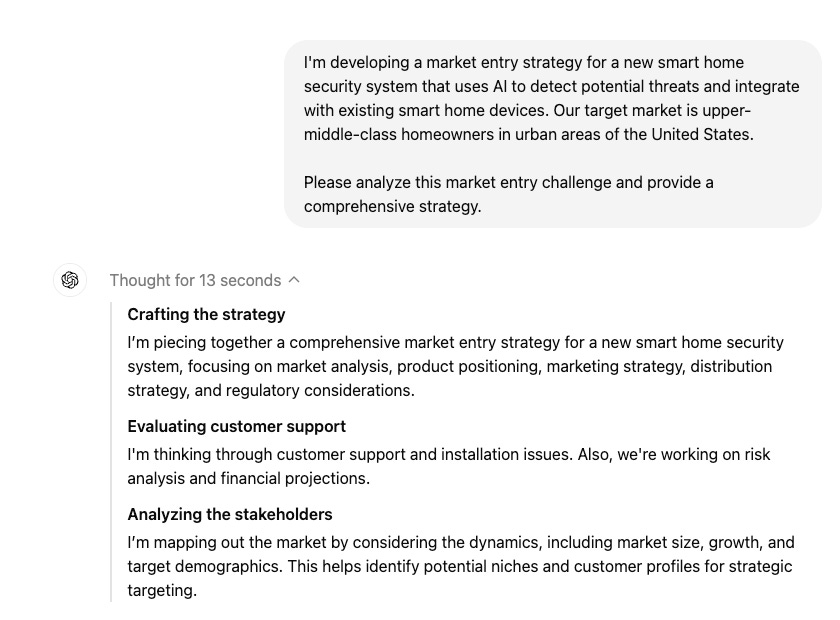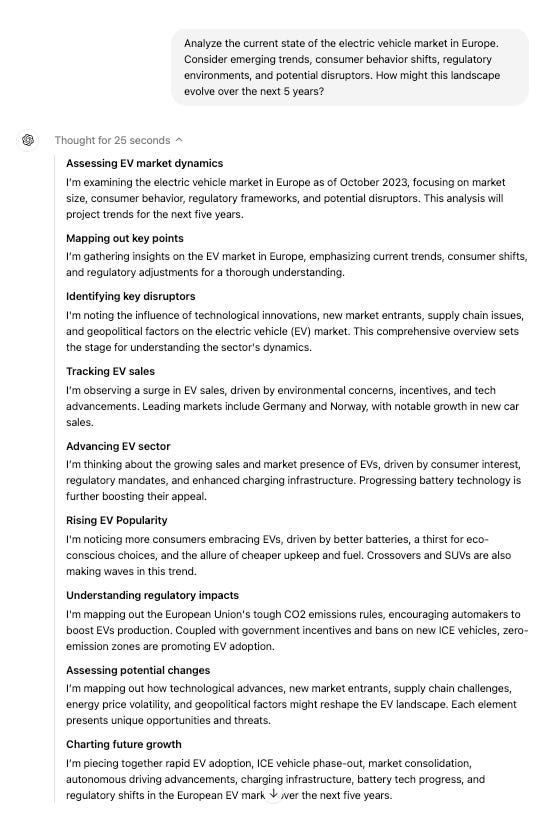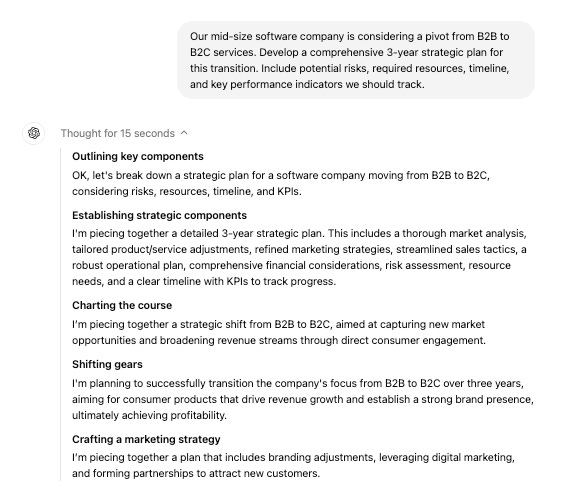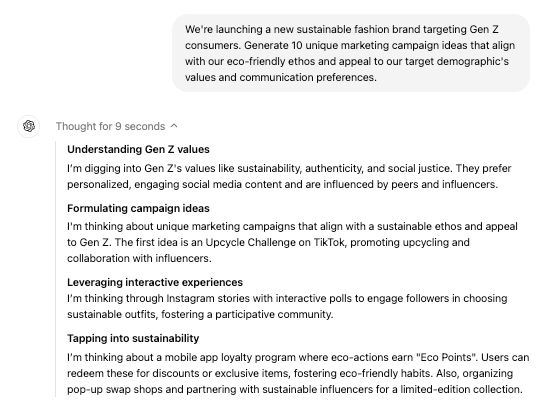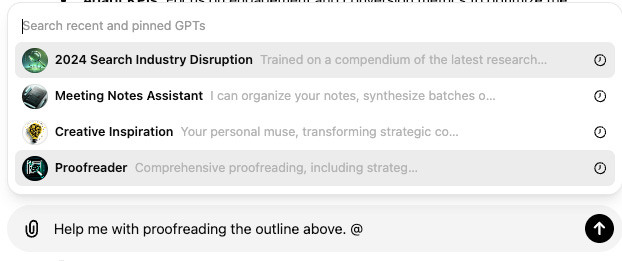What’s that you say? Another update from OpenAI? Just when we thought we were getting comfortable with the capabilities of GPT-4o, ChatGPT 4o1 was announced and it's turning heads for all the right reasons.
It’s not GPT-5. It’s not a polished update to GPT4o. It’s something entirely different – a big leap forward in AI reasoning that will change the game for knowledge workers across industries.
Cool, so what does it do?
At its core, 4o1 has enhanced reasoning capabilities. It takes more time to analyze problems, resulting in a deeper understanding and much more thoughtful output.
This new approach mimics human cognitive processes more closely than ever before. When presented with a query or problem, ChatGPT 4o1 doesn't immediately jump to an answer. Instead, it engages in what we might call "digital contemplation." The model generates an extensive internal chain of thought, which is a prompting method that encourages LLMs to break down complex problems into a series of intermediate steps, mimicking human-like reasoning. This technique was initially done by the user, providing the model with examples that demonstrate a step-by-step approach to solving the problem, which the model can then emulate when tackling new, similar problems. Now that level of reasoning is happening during that “Thinking” time you see on the screen when using the new model.
What does this mean in practice? As an example, imagine you're a business strategist asking the AI to help develop a market entry strategy for a new product. Rather than simply retrieving and regurgitating standard market entry frameworks, ChatGPT 4o1 will approach the problem with much more nuance and depth. It might start by breaking down the challenge into key components - market analysis, competitive landscape, potential customer segments, pricing strategies, and distribution channels.
Here’s how that looks below:
In fields requiring deep analytical thinking - like scientific research, strategic planning, or complex problem-solving - ChatGPT 4o1 is showing near PhD-level competence. The real breakthrough is how it's able to process and apply information in more sophisticated ways.
But here's where it gets really interesting for those of us who work in creative and strategic fields. 4o1 is showing remarkable aptitude in areas like market analysis, strategic planning, and even creative ideation.
More Examples:
Key Takeaways:
Based on the examples above, we can see clear evidence of ChatGPT 4o1's enhanced reasoning capabilities and why this "chain of thought" approach is so much more effective for users.
Let's break it down:
The Thinking Process is Structured: In all three examples, we see the AI breaking down complex problems into manageable components. This mimics how a human expert might approach these challenges, making the output more relatable and easier to follow. For instance, in the B2B to B2C transition example, the AI outlines key components like market analysis, operational planning, and financial considerations.
Self-Reflection and Clarity: The AI doesn't just list ideas; it shows its work. Phrases like "I'm thinking about..." and "I'm piecing together..." indicate an iterative thought process. This transparency allows users to understand how the AI arrived at its conclusions, making it easier to trust and build upon the suggestions.
Contextual Understanding: Each response demonstrates a deep understanding of the specific context. For the Gen Z sustainable fashion brand, the AI considers factors like social media influence and interactive experiences, showing it grasps current trends and Gen Z values.
Multifaceted Analysis: The responses go beyond surface-level answers. In the electric vehicle market analysis, the AI considers various factors simultaneously - market dynamics, consumer behavior, regulatory environments, and potential disruptors.
Forward-Thinking Perspective: The AI doesn't just analyze the current state but also projects future scenarios. This is evident in the EV market analysis where it charts future growth and considers potential changes in the landscape.
This chain of thought structuring is more effective for users because:
It provides insight into the reasoning process, allowing users to understand and critique the logic.
It offers a more comprehensive analysis, covering aspects the user might not have initially considered.
It mimics collaborative thinking, making it feel more like working with a human expert than a typical AI tool.
It allows for easier identification of assumptions and potential flaws in the reasoning.
The structured approach makes it easier for users to extract relevant information and build upon the AI's suggestions.
Badass.
A Guide for When You Should (and Should NOT use) 4o1
As powerful as ChatGPT 4o1 is, it's not a one-size-fits-all solution. Understanding when to leverage its capabilities and when to use good ol’ fashioned 4o (or Claude 3.5) is key to maximizing its value.
When to Use ChatGPT 4o1:
Complex Problem Solving: When you're facing a multifaceted business challenge that requires considering various angles and potential outcomes. For example, developing a go-to-market strategy for a new product line where you need to analyze market trends, competitive landscape, and potential customer segments simultaneously.
Ideation and Brainstorming: When you need to generate a wide range of creative ideas quickly. It's particularly useful for marketing campaigns, product features, or content ideas. The AI can provide a springboard for your own creativity.
Data Synthesis and Trend Analysis: When you need to make sense of large amounts of information and identify patterns or trends. For instance, analyzing market reports from various sources to spot emerging industry trends.
Scenario Planning: When you want to explore multiple potential future scenarios and their implications. This could be useful for long-term strategic planning or risk assessment.
First Draft Creation: When you need a starting point for a report, presentation, or strategy document. The AI can provide a structured outline that you can then refine and personalize.
When Not to Use ChatGPT 4o1:
Quick Fact Checks: When you need a straightforward answer to a simple question, ChatGPT 4o1's in-depth reasoning process might be overkill. For instance, if you just need to know the average population of 13th-century Paris, a simple single-shot prompt is more effective and faster.
Any Single-Step Task: When you need to perform a simple, one-step task like creating a basic to-do list, ChatGPT 4o1's detailed analysis isn't needed.
Any Immediate, Short Responses: In situations where you need an instant, brief response - like in a live meeting or presentation - ChatGPT 4o1's longer processing time and detailed outputs could be disruptive. Stick to 4o here.
Routine, Repetitive Tasks: For tasks that you perform frequently and don't require complex thinking - like formatting a document or sorting data - using ChatGPT 4o1 would be inefficient.
Binary Decisions: When you're facing a simple yes/no decision that doesn't require in-depth analysis, ChatGPT 4o1's nuanced approach isn't necessary. Trust your judgment or use simpler decision-making tools.
One big thing I’m excited about…
The integration of ChatGPT 4o1's enhanced reasoning capabilities into GPTs gets us MUCH closer to the autonomous agents that the AI community has been promising us. Imagine a suite of GPT agents that don't just execute tasks, but serve as true partners in our daily work. The power of customization and context building that GPTs unlock, coupled with the advanced problem-solving skills of 4o1, will truly make GPTs the most powerful AI tools we have ever seen.
One feature that has been overlooked is ChatGPT’s interaction feature. This allows users to ‘call in’ other GPTs to assist on tasks within a workflow. See here:
That’s where we truly get an interconnected system of AI agents, each leveraging 4o1's capabilities in its specific domain. A market analysis agent might work in tandem with a creative ideation agent and a strategic planning agent, collectively tackling complex business challenges. The market analyst could dive deep into industry trends and consumer behavior, feeding insights to the creative agent for innovative campaign ideas, while the strategic planner synthesizes this information into comprehensive business strategies. Throughout this process, each agent would provide transparent, step-by-step reasoning, allowing users to understand and trust their suggestions.
This level of AI collaboration could dramatically enhance our decision-making processes, spark creativity, and drive innovation across industries.
What a time to be alive. Carry on. And happy prompting, comrades.




